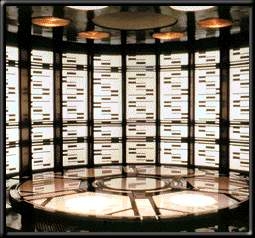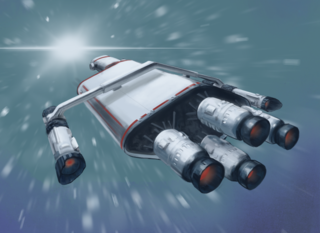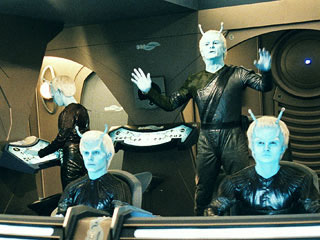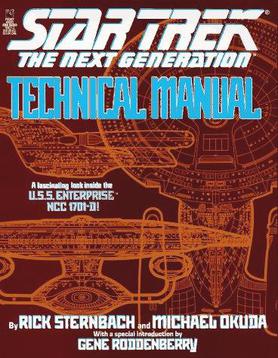The fictional technology in Star Trek has borrowed many ideas from the scientific world. Episodes often contain technologies named after or inspired by real-world scientific concepts, such as tachyon beams, baryon sweeps, quantum slipstream drives, and photon torpedoes. Some of the technologies created for the Star Trek universe were done so out of financial necessity. For instance, the transporter was created because the limited budget of Star Trek: The Original Series (TOS) in the 1960s did not allow expensive shots of spaceships landing on planets.
In the Star Trek fictional universe, shields refer to a 23rd and 24th century technology that provides starships, space stations, and entire planets with limited protection against damage. They are sometimes referred to as deflectors, deflector shields, or screens. Types of shields include navigational deflectors.

A transporter is a fictional teleportation machine used in the Star Trek science fiction franchise. Transporters allow for teleportation by converting a person or object into an energy pattern, then sending ("beaming") it to a target location or else returning it to the transporter, where it is reconverted into matter ("rematerialization"). Since its introduction in Star Trek: The Original Series in 1966, the name and similar concepts have made their way to other science fiction scenarios, in literature, games (SimEarth), etc.
The Star Trek fictional universe contains a variety of weapons, ranging from missiles to melee. The Star Trek franchise consists mainly of several multi-season television shows and a dozen movies, as well as various video games and inspired merchandise. Many aspects of the Star Trek universe impact modern popular culture, especially its fictitious terminology and the concept of weaponry on spacecraft. The franchise has had a widespread influence on its audiences from the late 20th to early 21st century. Notably, Star Trek's science fiction concepts have been studied by real scientists; NASA described it in relation to the real world as "entertaining combination of real science, imaginary science gathered from lots of earlier stories, and stuff the writers make up week-by-week to give each new episode novelty." For example, NASA noted that the Star Trek "phasers" were a fictional extrapolation of real-life lasers, and compared them to real-life microwave based weapons that have a stunning effect.

A warp drive or a drive enabling space warp is a fictional superluminal spacecraft propulsion system in many science fiction works, most notably Star Trek, and a subject of ongoing physics research. The general concept of "warp drive" was introduced by John W. Campbell in his 1957 novel Islands of Space and was popularized by the Star Trek series. Its closest real-life equivalent is the Alcubierre drive, a theoretical solution of the field equations of general relativity.

In the fictional universe of Star Trek the United Federation of Planets (UFP) is the interstellar government with which, as part of its space force Starfleet, most of the characters and starships of the franchise are affiliated. Commonly referred to as "the Federation", it was introduced in the original Star Trek television series. The survival, success, and growth of the Federation and its principles of freedom have become some of the Star Trek franchise's central themes.

In the Star Trek fictional universe, LCARS is a computer operating system. Within Star Trek chronology, the term was first used in the Star Trek: The Next Generation series.

Andorians are a fictional race of humanoid extraterrestrials in the American science fiction franchise Star Trek. They were created by writer D. C. Fontana. Within the Star Trek narrative, they are native to the blue icy Class M moon, Andoria. Distinctive traits of Andorians include their blue/green skin, a pair of cranial antennae, and white hair.

Mr. Scott's Guide to the Enterprise, written and illustrated by Lora Johnson, known as Shane Johnson at that time, is a book describing the post-refit USS Enterprise from the Star Trek fictional universe. It is written from the viewpoint of the ship's chief engineer, Montgomery Scott. The manual was first printed and published by Pocket Books in 1987.

The Star Trek Star Fleet Technical Manual is a fiction reference book by Franz Joseph Schnaubelt, about the workings of Starfleet, a military, exploratory, and diplomatic organization featured in the television series Star Trek.
Star Trek: The Magazine was an authorized monthly tabloid-size periodical published in the United States and Canada by Fabbri Publishing (US) devoted to the Star Trek franchise. It ran for 48 issues, from May 1999 through April 2003, covering nearly 5,000 pages. There were three volumes, the first with 24 issues, and the latter two with 12 issues each.
The Star Trek canon is the set of all material taking place within the Star Trek universe that is considered official. The definition and scope of the Star Trek canon has changed over time. Until late 2006, it was mainly composed of the live-action television series and films before becoming a more vague and abstract concept. From 2010 until 2023, the official Star Trek website's site map described their database, which listed both animated and live-action series and films as its sources, as "The Official Star Trek Canon."

Michael Okuda is an American graphic designer best known for his work on Star Trek including designing futuristic computer user interfaces known as "okudagrams".
Richard Michael Sternbach is an illustrator who is best known for his space illustrations and his work on the Star Trek television series.
Franz Joseph was an artist and author loosely associated with the 1960s American television show Star Trek.

Star Trek: The Next Generation: Technical Manual is a paperback reference guide detailing the inner and other workings of the fictional Federation starship Enterprise-D and other aspects of technology that appeared in the television series Star Trek: The Next Generation.
In the Star Trek fictional universe, dilithium is an invented material which serves as a controlling agent in the matter-antimatter reactors. In the original series, dilithium crystals were rare and could not be replicated, making the search for them a recurring plot element. According to a periodic table shown during a Next Generation episode, it has the atomic number 87, and the chemical symbol Dt.
Star Trek: The Next Generation Interactive Technical Manual is a multimedia application software program published by Simon and Schuster Interactive in 1994. Based on the then-recently ended TV series Star Trek: The Next Generation, it allows users to explore a computer-generated simulation of the spacecraft USS Enterprise NCC-1701-D, the principal setting of the series. The software uses Apple Computer's QuickTime VR, a technology which enables users to view every side of 3D rendered objects, and includes a virtual tour given by Jonathan Frakes. The Interactive Technical Manual was billed as the first CD-ROM title built with QuickTime VR.









